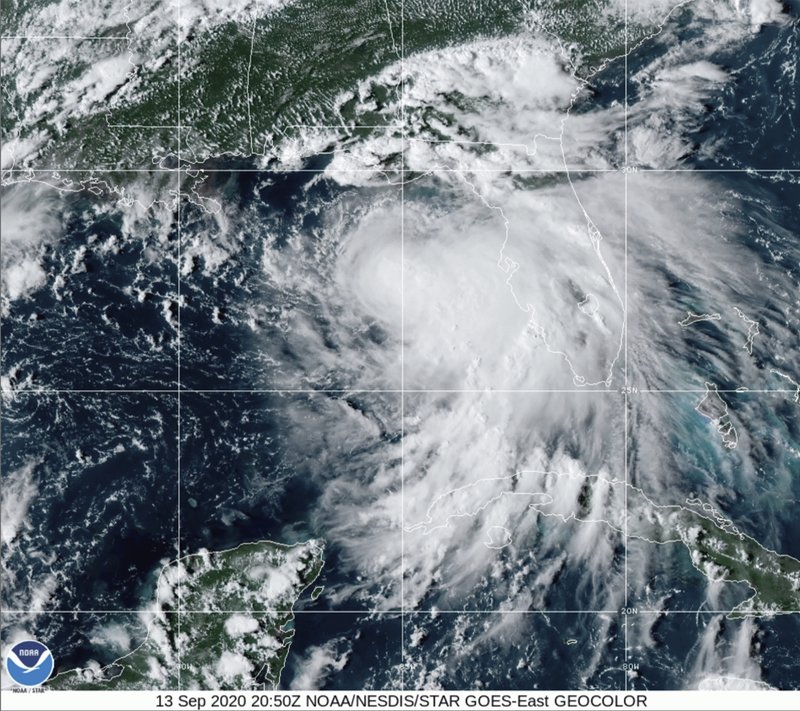Tropical Storm Sally slowed down Sunday as it churned northward toward the U.S. Gulf Coast, increasing the risk of heavy rain and dangerous storm surge before an expected strike as a Category 2 hurricane in southern Louisiana.
“I know for a lot of people this storm seemed to come out of nowhere,” said Louisiana Gov. John Bel Edwards. “We need everybody to pay attention to this storm. Let’s take this one seriously.”
Forecasters from the National Hurricane Center in Miami said Sally is expected to become a hurricane on Monday and reach shore by early Tuesday, bringing dangerous weather conditions, including risk of flooding, to a region stretching from Morgan City, Louisiana, to Ocean Springs, Mississippi.
Edwards urged people to prepare for the storm immediately. He also said there are still many from southwestern Louisiana who evacuated from Hurricane Laura into New Orleans — exactly the area that could be hit by Sally, which is a slow moving storm.
“Based on all of the available information, we have every reason to believe this storm represents a significant threat,” he said, adding that the coronavirus adds a layer of complexity to storm preparations.
There are still some 5,400 members of the state’s National Guard mobilized from Laura, and they will assist with Sally.
In Mandeville, a city about 35 miles (56 kilometers) north of New Orleans, resident Chris Yandle has purchased a week’s worth of groceries and moved all his patio furniture into his family’s house and shed in preparation for the storm.
“I’m mostly trying to stay calm — especially with a family of four and a dog to worry about,” Yandle said. “I’ve lived through many hurricanes growing up in Louisiana, but I haven’t felt this anxious about a hurricane in my life.”
Mississippi officials warned that the storm was expected to coincide with high tide, leading to significant storm surge.
“It needs to be understood by all of our friends in the coastal region and in south Mississippi that if you live in low-lying areas, the time to get out is early tomorrow morning,” Gov. Tate Reeves said late Sunday.
In Waveland, Mississippi, Joey Chauvin used rope to tie down a tall wooden post topped with a statue of a pelican serving as a marker at the driveway leading to his weekend camp. He said a matching pelican marker on the opposite side of the driveway was washed away in Tropical Storm Cristobal earlier this summer. That storm pushed more than 3 feet (1 meter) of water into the area.
“If this one hits the coast as a Cat 2, I’m thinking we’re gonna have at least six to seven feet of water where we’re standing at,” Chauvin said. “So, yeah, we’re definitely not going to stay.”
The system was moving northwest at 8 mph (13 kph) on Sunday night. It was centered 140 miles (225 kilometers) south-southwest of Panama City, Florida, and 185 miles (300 kilometers) east-southeast of the mouth of the Mississippi River. On Sunday, Florida’s Gulf Coast was battered with windy, wet weather.
Pensacola, on Florida’s Panhandle, was bracing for 10 to 15 inches (25 to 38 centimeters) of rain.
Sally could produce rain totals up to 24 inches (61 centimeters) by the middle of the week, forecasters said. Its maximum sustained winds Sunday evening were 60 mph (95 kph).
“That system is forecast to bring not only damaging winds but a dangerous storm surge,” said Daniel Brown of the Hurricane Center. ”Because it’s slowing down it could produce a tremendous amount of rainfall over the coming days.”
This isn’t the only storm in the Atlantic basin. Paulette gained hurricane status late Saturday and was expected to bring storm surge, coastal flooding and high winds to Bermuda, according to a U.S. National Hurricane Center advisory. On Sunday evening, it was located about 80 miles (125 kilometers) southeast of Bermuda. Its maximum sustained winds were 85 miles per hour (137 kph).
Once a tropical storm, Rene was forecast to become a remnant low Monday. Tropical Depression Twenty was expected to strengthen this week and become a tropical storm by Tuesday, forecasters said.
“This week is essentially the peak of the hurricane season,” said Brown. “It is quite active across the tropics today.”
A mandatory evacuation has already been issued in Grand Isle, Louisiana, ahead of the storm. On Saturday, New Orleans Mayor LaToya Cantrell issued a mandatory evacuation order for Orleans Parish residents living outside of the parish’s levee protection system.
Louisiana Gov. John Bel Edwards declared a state of emergency on Saturday.
A Hurricane Warning is in effect for Morgan City, Louisiana, to the Mississippi/Alabama border. A Hurricane Watch is in effect from the Mississippi/Alabama border to the Alabama/Florida border.
All northern Gulf Coast states are urging residents to prepare.
“It is likely that this storm system will be impacting Alabama’s Gulf Coast. While it is currently not being predicted as a direct hit to our coastal areas, we know well that we should not take the threat lightly,” said Alabama Gov. Kay Ivey. She urged residents to prepare and stay informed of the storm’s path in the coming days.
(AP)











